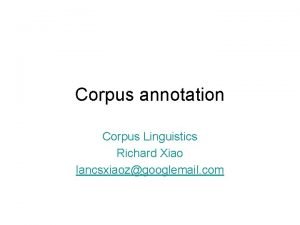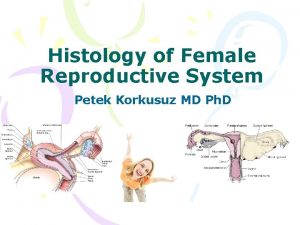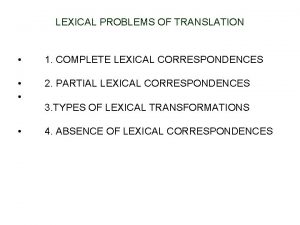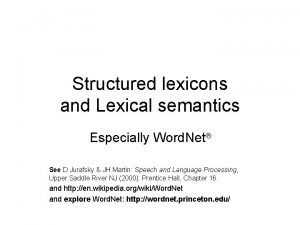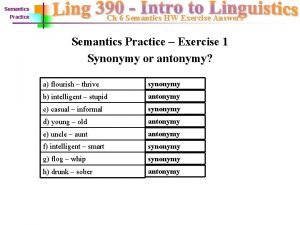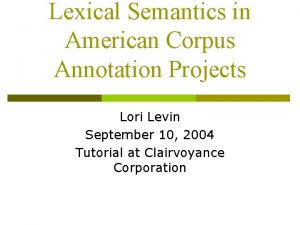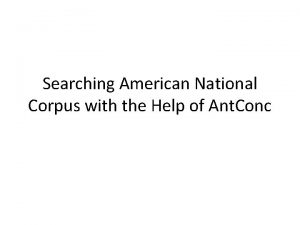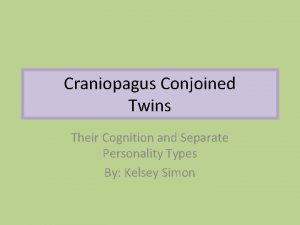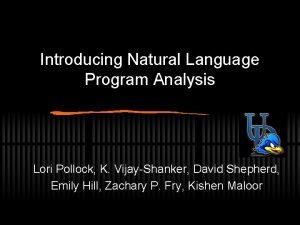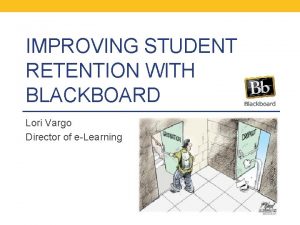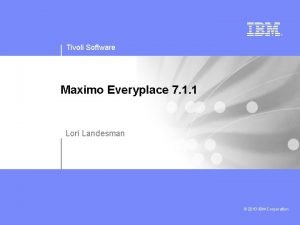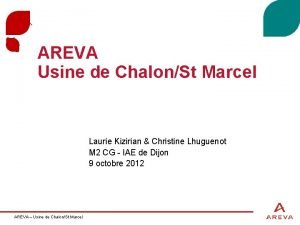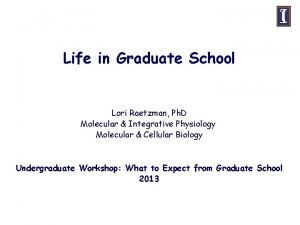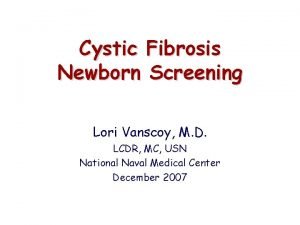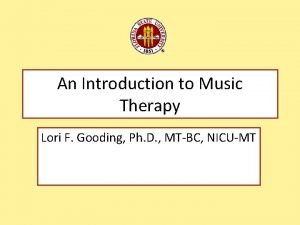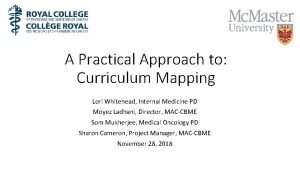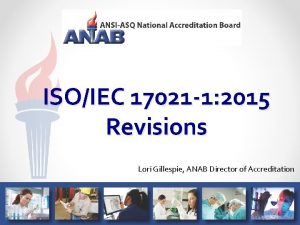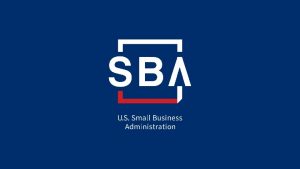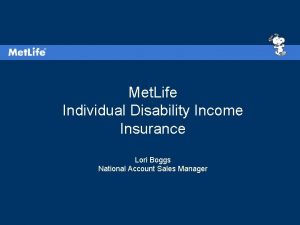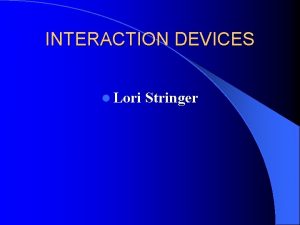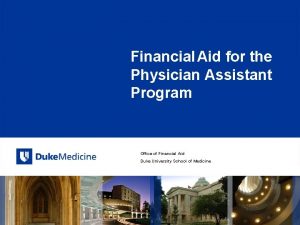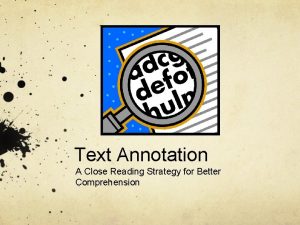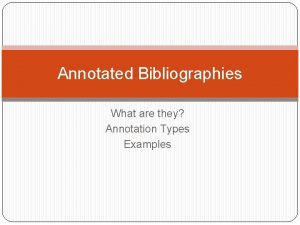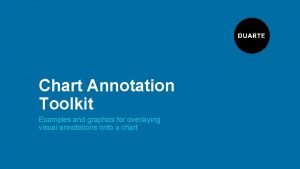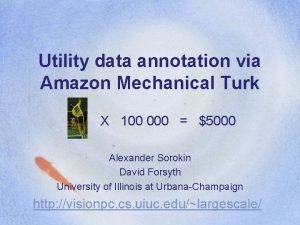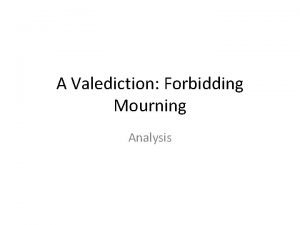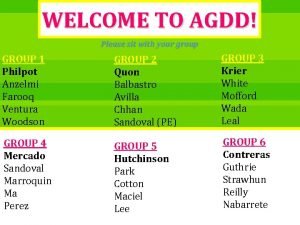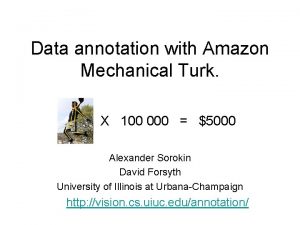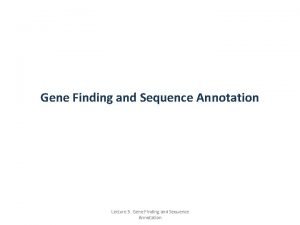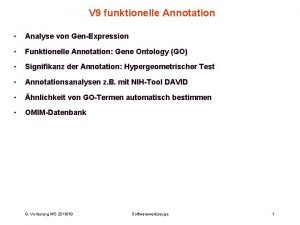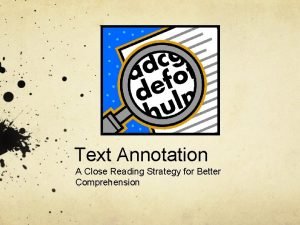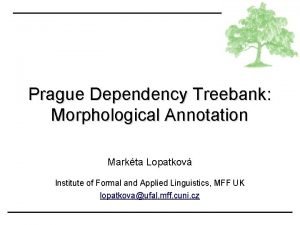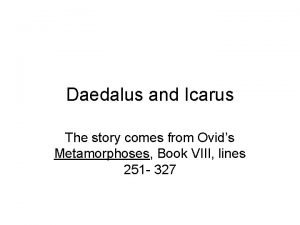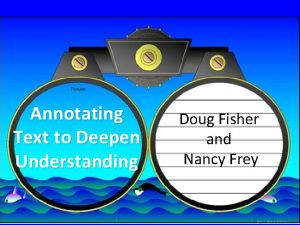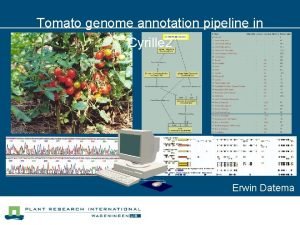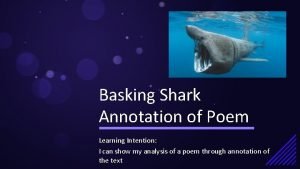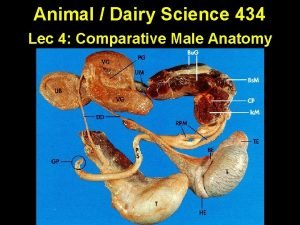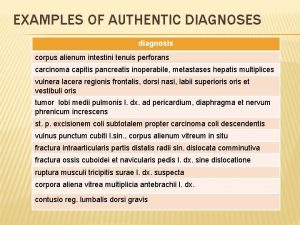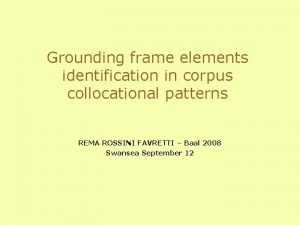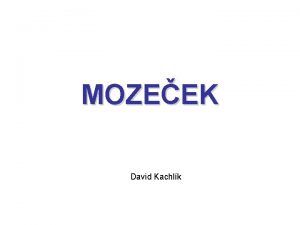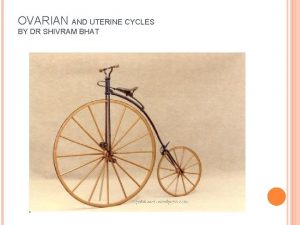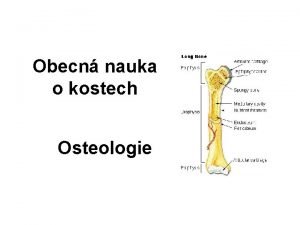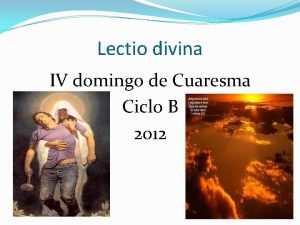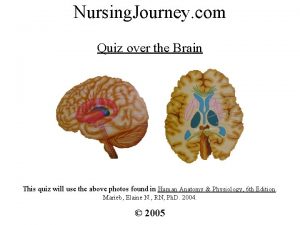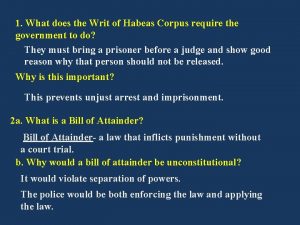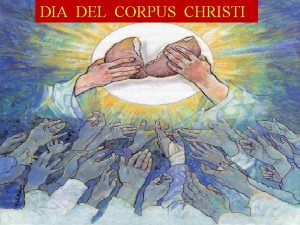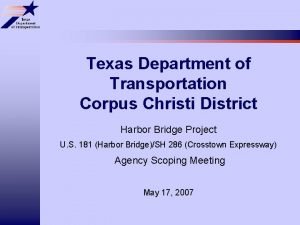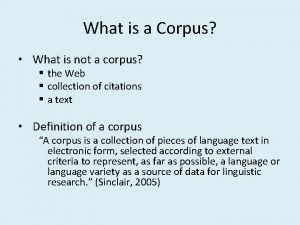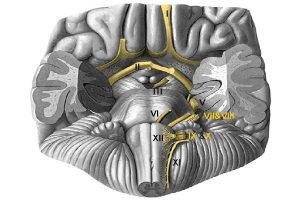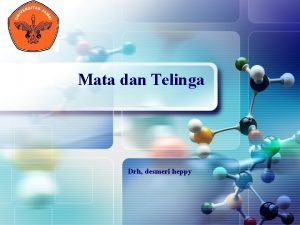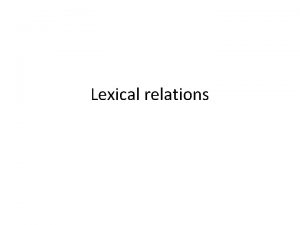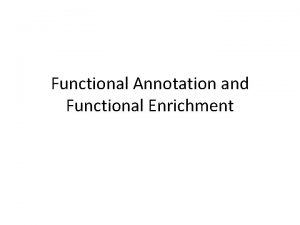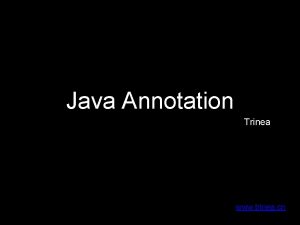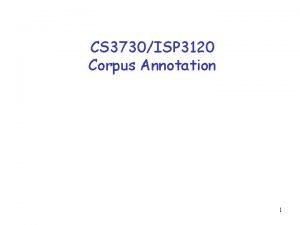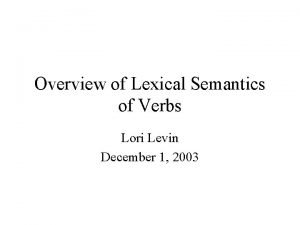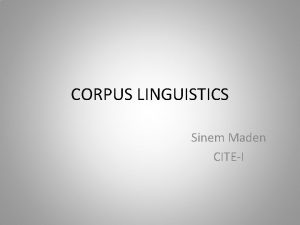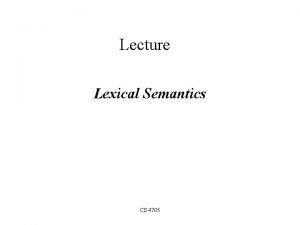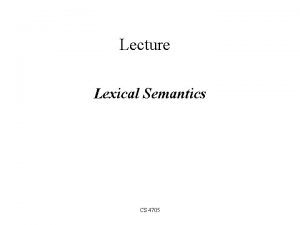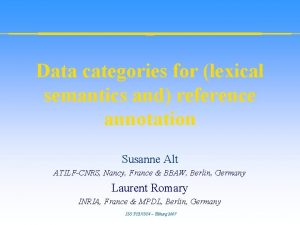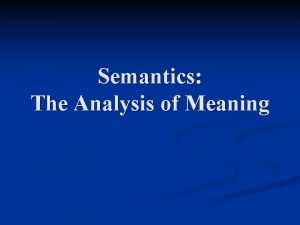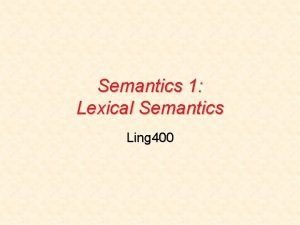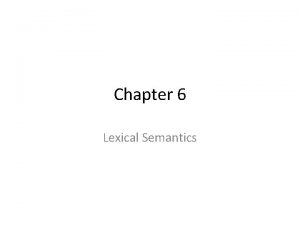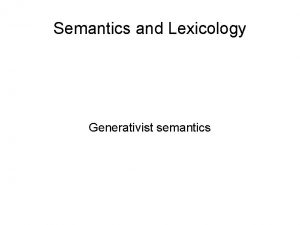Lexical Semantics in American Corpus Annotation Projects Lori















































































































- Slides: 111

Lexical Semantics in American Corpus Annotation Projects Lori Levin September 10, 2004 Tutorial at Clairvoyance Corporation

What is Lexical Semantics? p p Lexical semantics is about the meanings of words. This tutorial is about the meanings of verbs and their arguments: n n n Sam opened the door with a key. They key opened the door. The door was opened by Sam with a key. The door opened (with a key). Sam bought a book from Sue sold a book to Sam.

Types of semantics not covered in this tutorial p Sentence-level meaning n Truth conditions of sentences This is a picture of a cell phone. (true) p This is a picture of a book. (false) p n Compositional semantics p n How the meanings of a noun phrase and a verb phrase are combined into the meaning of a sentence. Quantifier scope. p Everyone here speaks two languages.

Aspects of lexical semantics not covered in this tutorial p p Nouns, adjectives, adverbs, and prepositions Selectional restrictions: n Colorless green ideas sleep furiously. p p Count and mass nouns: n n p Chomsky, 1957, Syntactic Structures There was water all over the driveway. (mass) There was dog all over the driveway. (count) Synonymy, hyponymy, antonymy, etc. n n n car-automobil car-vehicle Hot-cold

Outline p Background n n p Predicates and Arguments Valency and subcategories of verb Optional arguments and adjuncts Semantic Roles Three approaches to lexical semantics n A linguistic theory p n A lexicon project p n Frame Semantics A corpus annotation project (also building a lexicon) p p Lexical Conceptual Structure Prop. Bank A multi-lingual semantic corpus annotation project

Predicates and Arguments p Verbs (and sometimes nouns and adjectives) describe events, states, and relations that have a certain number of participants. n The children devoured the spaghetti. p n The teacher handed the book to the student. p n Three particpants. Problems exist. p p Two participants One participant. The participants are referred to as arguments of the verb. (Like arguments of a function. )

Valency and Subcategorization p Fillmore and Kay, Lecture Notes, Chapter 4: n n n n The children devoured the spaghetti. *The children devoured the spaghetti the cheese. She handed the baby a toy. *She handed the baby. *She handed the toy. Problems exist. *Problems exist more problems.

Grammaticality An asterisk (*) indicates that a sentence is ungrammatical. p A large percentage of linguists make these assumptions: p n Human languages are like formal languages. p n Some sentences are in the set of legal sentences and some are not A human can act like a machine that accepts legal sentences and rejects illegal sentences.

Valency p The number of participants is called the verb’s valence or valency. n n n p Devour has a valency of two. Hand has a valency of three. Exist has a valency of one. Linguists took this term from chemistry – how many electrons are missing from the outer shell. n The first linguist to use the term was Charles Hockett in the 1950’s.

Subcategorization p p Verbs are divided into subcategories that have different valencies. Here is how the terminology works: n Exist, devour, and have different subcategorizations p n n n i. e. , They are in different subcategories Devour subcategorizes for a subject and a direct object. Devour is subcategorized for a subject and a direct object. Devour takes two arguments, a subject and a direct object (or an agent and a patient).

Arguments are not always Noun Phrases p The italicized phrases are also arguments: n He looked very pale. p n The solution turned red. p n Verb Phrase He started singing a song. p n Adjective Phrase I want to go. p n Adjective Phrase Verb Phrase We drove to New York. p Prepositional Phrase

Optional and Obligatory Arguments p The direct object of eat is optional: n n p The children ate cake. The direct object of devour is not optional: n n *The children devoured the cake.

Optional Arguments The dog ran. p The dog ran from the house to the creek through the garden along the path. p

Optional vs. Invisible Arguments a. What happened to the cake? b. The children ate. b’. The children ate it. In English, Sentences b and b’ do not mean the same thing in this context. Compare to Japanese and Chinese.

Adjuncts p Locations, times, manners, and other things that can go with almost any sentences are called adjuncts. n The children ate the cake quickly at 2: 00 in the kitchen.

How to tell arguments from adjuncts p p There are some general guidelines that are not always conclusive. Adjuncts are always optional. n p but some arguments are optional too Repeatability: n The children devoured the cake at 2: 00 on Monday. p n The children devoured the cake in Pittsburgh in a restaurant. p n Two temporal adjuncts Two locative adjuncts *The children devoured the cake the dessert. p arguments are not repeatable

Semantic Roles: Motivation p The verb open appears in different subcategorization patterns: n n p Sam opened the door with a key. The key opened the door. The door was opened by Sam with a key. Sam’s opening of the door with a key How can we represent the meanings of these sentences in a way that shows that they are related?

Semantic Roles: Motivation p These sentences do not have the same meaning even though they have the same verb: n n Sam interviewed Sue interviewed Sam.

Semantic Roles: Motivation These sentences mean roughly the same thing even though they use different verbs: Sam bought a toy from Sue. p Sue sold a toy to Sam. p

Semantic Roles: Motivation p The way to express riding a vehicle to a location is different in different languages: n n n Sam took a bus to school. Sam ascended to the bus and went to school. (Hebrew) Sam riding on the bus, went to school. (Japanese) Sam sat on the bus, went to school. (Chinese) Sam went to school by bus. Sam went to school by taking a bus.

Semantic role names in a meaning representation n n p Sam opened the door with a key. The key opened the door. The door was opened by Sam with a key. Sam’s opening of the door with a key Open n Agent: Sam Patient: door Instrument: key

Semantic Roles Names in a Meaning Representation p These sentences do not have the same meaning: n n Sam interviewed Sue interviewed Sam. p Interview n n p Agent: Sam Patient: Sue Interview n n Agent: Sue Patient: Sam

Examples of Semantic Roles p Agent: an agent acts volitionally or intentionally n n The students worked. Sue baked a cake.

Examples of Semantic Roles p Experiencer and Perceived: n n An experiencer is an animate being that perceives something, cognizes about something, or or experiences an emotion. The perceived is the thing that the experiencer perceives or the thing that caused the emotional response. p The students like linguistics. § (emoter and perceived) p The students saw a linguist. § (perceiver and perceived) p Linguistics frightens the students. § (emoter and perceived) p The students thought about linguistics. § (cognizer and perceived)

Examples of Semantic Roles p Patient: A patient is affected by an action. n n p Beneficiary: A beneficiary benefits from an event n n p My dog died on me. Instrument: n n p Sue baked a cake for Sam. Sue baked Sam a cake. Malefactive: Someone is affected adversely by an event. n p Sam kicked the ball. Sue cut the cake. The boy opened the door with a key. The key opened the door. Location: n n The clock stands on the shelf. I put the book on the shelf.

Three approaches to semantic roles in meaning representations p Ray Jackendoff (1972, 1990) n n n p p Lexical Conceptual Structure The Motion/Location Metaphor Semantic Roles Charles Fillmore, Frame. Net Project n Linguistic Theory Lexicon Frame-semantics Martha Palmer, Prop. Bank Project Corpus Annotation n n Predicate-specific role names: Proto-grammatical relations

Ray Jackendoff Semantic Interpretation in Generative Grammar, MIT Press, 1972 p Semantic Structures, MIT Press, 1990. p n n Theory of human cognition Used by many computational linguists

Lexical Conceptual Structure p Primitives: n n p Types of entities: n p GO, BE, STAY, CAUSE, and several more TO, FROM, AWAY, TOWARD, VIA, and several more Event, State, Thing, Place, Path Other tiers of representation are added in order to capture nuances of meaning and grammar: n n n Cause and affectedness Manner Actor and undergoer (see discussion of Prop. Bank)

Example of Lexical Conceptual Structure Sam threw the ball across the room. [event CAUSE [thing SAM] [event GO [thing BALL] [path TO [place AT [ thing other-side-of-room]]]]]

Lexical Conceptual Structure and Semantic Role Names Sam threw the ball across the room. [event CAUSE [thing SAM] agent [event GO [thing BALL] theme [path TO [place AT [ thing other-side-of-room]]]]] goal

The Motion/Location Metaphor p J. S. Gruber, Studies in Lexical Relations, MIT Dissertation, 1965. n n n Agent: causes, manipulates, affects Theme: changes location, is located somewhere, or exists Source: the starting point of the motion Goal: the ending point of the motion Path: the path of the motion

Examples of Location and Directed Motion Many problems still exist. p The clock sits on the shelf. p The ball rolled from the door to the window along the wall. p Same walked from his house to town along the river. p Sue rolled across the room. p The car turned into the driveway. p

Being in a state or changing state The car is red. p The ice cream melted. p The glass broke. p Sam broke the glass. p The paper turned from red to green. p The fairy godmother turned the pumpkin into a coach. p

Having or Changing possession The teacher gave books to the students. p The teacher gave the students books. p The students have books. p

Exchange of Information The teacher told a story to the students. p The teacher told the students a story. p

Extent The road extends/runs along the river from the school to the mall. p The string reaches the wall. p The string reaches across the room to the wall. p

Strong points of LCS and the Motion/Location Metaphor p Sam manipulates a key, having an effect on the door, causing it to go from the state of being closed to the state of being open. n n Sam opened the door with a key. The key opened the door. The door was opened by Sam with a key. Sam’s opening of the door with a key

Strong points of LCS and the Motion/Location Metaphor A toy goes from Sue to Sam. Some money goes from Sam to Sue. p Differences in the causation tier. p n n Sam bought a toy from Sue sold a toy to Sam.

Strong points of LCS and the Motion/Location Metaphor p Supports some inferences: n n If X goes from A to B, then X is no longer at A. If X is created (begins to BE) during event Y, then X doesn’t exist until Y is finished.

Strong or weak point? p LCS wasn’t designed with this kind of thing in mind, but it could be made to work. n n n Sam took a bus to school. Sam ascended to the bus and went to school. (Hebrew) Sam riding on the bus, went to school. (Japanese) Sam sat on the bus, went to school. (Chinese) Sam went to school by bus. Sam went to school by taking a bus.

Problem with Thematic Roles and the Motion/Location Metaphor p It is not clear how to apply the metaphor to many verbs (Fillmore and Kay, Lecture Notes, pages 4 -22) n n n He risked death. We resisted the enemy. She resembles her mother.

LCS Resources p p p Bonnie Dorr, University of Maryland http: //www. umiacs. umd. edu/~bonnie/LCS_Da tabase_Documentation. html LCS Lexicon for English n n n p English word senses are mapped to Word. Net Handcrafted lexical entries for around 4000 verbs Automatically produced entries may be available for a full-sized lexicon LCS Dictionaries for other languages may be available n May be handcrafted or produced partially automatically

Problem with Thematic Roles and the Motion/Location Metaphor p It is not clear how to apply the metaphor to many verbs (Fillmore and Kay, Lecture Notes, pages 4 -22) n n n He risked death. We resisted the enemy. She resembles her mother.

Charles Fillmore, Collin Baker, and others Frame. Net Project http: //www. icsi. berkeley. edu/~framenet/ p Frame semantics p n n Frames are networked using several relations Based on corpus analysis Lexical entries for around 7500 English verbs p Other Frame. Net projects in p n n Spanish Japanese

Advantage of Frame Semantics p Frame. Net was designed to capture the similarities in sentences like these. n Ride-vehicle frame. Sam took a bus to school. Sam ascended onto the bus and went to school. (Hebrew) p Sam riding on the bus, went to school. (Japanese) p Sam sat on the bus, went to school. (Chinese) p Sam went to school by bus. p Sam went to school by taking a bus. p

Frame Semantics compared to the Motion/Location Metaphor p Frame Semantics has n n Many primitives Many semantic roles

Frame. Net strong and weak points Frame. Net is still under development and may change frequently. p Versions are clearly identified. p Lexical entries are very carefully hand crafted. p

Martha Palmer and others The Prop. Bank Project http: //www. cis. upenn. edu/~ace/ p Annotate the Penn Tree. Bank with predicate-argument information p Corpus can be used for automatic learning of the surface realization of each argument p

Prop. Bank and Frame. Net: Close ties p Prop. Bank lexical entries are linked to Frame. Net entries. n p This paper contains some comparisons of Prop. Bank and Framenet n p There are more Prop. Bank entries than Frame. Net entries http: //www. cis. upenn. edu/~dgildea/gildeaacl 02. pdf See also Verb. Net n http: //www. cis. upenn. edu/group/verbnet/

Proto-roles and verb-specific roles p http: //www. cis. upenn. edu/~dgildea/Verbs/ p Abandon n Arg 0: abandoner n Arg 1: thing abandoned, left behind n Arg 2: attribute of arg 1

Prop. Bank: multiple surface realizations of arguments n n n n Sam opened the door with a key. The key opened the door. The door was opened by Sam with a key. Sam’s opening of the door with a key Arg 0: opener Arg 1: thing opening Arg 2: instrument Arg 3: benefactive Sam door key

Prop. Bank: How are lexical entries used by annotators? Intercoder agreement is a high priority for Prop. Bank. p Role names like agent and theme can be confusing. p Verb-specific role names are more clear. p

Annotation Procedure Identify the verb in a sentence. p Look it up in the Prop. Bank lexicon. p Assign arg 0…arg-n appropriately by looking at the verb-specific roles. p n Always use the same arg-n for the same verbspecific role.

What are the arg-n’s? The arg-n labels are arbitrary labels. p However, Prop. Bank tries to use them consistently across verbs. p n n Arg 0 tends to be an agent or the argument most likely to be the subject in active voice. Arg 1 tends to be a theme or patient or the thing most likely to be The direct object of a transitive verb in active voice p The subject of a verb in passive voice p The subject of an intransitive verb p

Prop. Bank was not designed for this p Sam took a bus to school. p Sam ascended onto the bus and went to school. (Hebrew) p Sam riding on the bus, went to school. (Japanese) p Sam sat on the bus, went to school. (Chinese) p Sam went to school by bus. p Sam went to school by taking a bus. p But it is linked to Frame. Net

IAMTC (Interlingua Annotation of Multilingual Text Corpora) Project http: //aitcnet. org/nsf/iamtc/ p Collaboration: p n n n New Mexico State University of Maryland Columbia University MITRE Carnegie Mellon University ISI, University of Southern California

Goals of IAMTC p Interlingua design n p Annotation methodology n p Three levels of depth manuals, tools, evaluations Annotated multi-parallel texts n n Foreign language original and multiple English translations Foreign languages: Arabic, French, Hindi, Japanese, Korean, Spanish

Motivation for Corpus and Data p Examine the surface realization of many phenomena n In one language: many surface realizations of the same phenomenon p p n I think it is raining. It is probably raining. Across languages: different syntactic constructions are used to express the same ideas

IL Development: Staged, deepening p p IL 0: simple dependency tree gives structure IL 1: semantic annotations for Nouns, Verbs, Adjs, Advs, and Theta Roles n n n n p Not yet ‘semantic’—”buy”≠“sell’, many remaining simplifications Concept ‘senses’ from ISI’s Omega ontology Theta Roles from Dorr’s LCS work Elaborate annotation manuals Tiamat annotation interface Post-annotation reconciliation process and interface Evaluation scores: annotator agreement IL 2: that comes next…

Details of English IL 0 Deep syntactic dependency representation: p n n Removes auxiliary verbs, determiners, and some function words Normalizes passives, clefts, etc. Removes strongly governed prepositions Includes syntactic roles (Subj, Obj) Construction: p n Dependency parsed using Connexor (English) – n p Tapanainen and Jarvinen, 1997 Hand-corrected Extensive manual and instructions on IAMTC Wiki website

IL 0 coding manuals for other languages: Japanese p Spanish p Korean (in progress) p Hindi (in progress) p French (in progress) p

Example of IL 0 Tr. Ed, Pajas, 1998 Sheikh Mohammed, who is also the Defense Minister of the United Arab Emirates, announced at the inauguration ceremony that “we want to make Dubai a new trading center”

Example of IL 0 p Sheikh Mohammed, who is also the Defens Minister of the United Arab Emirates, announced at the inauguration ceremony that “we want to make Dubai a new trading center” announced V Root Mohamed PN Subj Sheikh PN Mod Defense_Minister PN Mod who Pron Subj also Adv Mod of P Mod UAE PN Obj at P Mod ceremony N Obj inauguration N Mod

Dependency parser and Omega ontology Omega (ISI): 110, 000 concepts (Word. Net, Mikrokosmos, etc. ), 1. 1 mill instances URL: http: //omega. isi. edu Dependency parser (Prague)

Details of IL 1 p Intermediate semantic representation: n Annotations performed manually by each person alone p p n p No treatment of prepositions, quantification, negation, time, modality, idioms, proper names, NP-internal structure… Nodes may receive more than one concept n p Associate open-class lexical items with Omega Ontology items Replace syntactic relations by one of approx. 20 semantic (theta) roles (from Dorr), e. g. , AGENT, THEME, GOAL, INSTR… Average: about 1. 2 Manual under development; annotation tool built

Example of IL 1 Sheikh Mohammed, who is also the Defense Minister of the United Arab Emirates, announced at the inauguration ceremony that “we want to make Dubai a new trading center”

Example of IL 1: internal representation The study led them to ask the Czech government to recapitalize CSA at this level. [3, [2, [4, [6, lead, V, lead, Root, LEAD<GET, GUIDE] study, N, study, AGENT, SURVEY<WORK, REPORT] they, N, they, THEME, ---] ask, V, ask, PROPOSITION, ---] [9, government, N, government, GOAL, AUTHORITIES, Semantic GOVERNMENTAL-ORGANIZATION] Roles [8, Czech, Adj, Czech, MOD, CZECH~CZECHOSLOVAKIA, ---] [11, recapitalize, V, recapitalize, PROP, CAPITALIZE<SUPPLY, INVEST] [12, csa, N, csa, THEME, AIRLINE<LINE, ---] [16, at, P, value_at, GOAL, ---] [15, level, N, level, ---, DEGREE, MEASURE] [14, this, Det, this, ---, ---] Concepts from the Omega Ontology

Tiamat: annotation interface For each new sentence: Step 1: find Omega concepts for objects and events Step 2: select event frame (theta roles) Candidate concepts

Omega ontology p p Single set of all semantic terms, taxonomized and interconnected (http: //omega. isi. edu ) Merger of existing ontologies and other resources: n n n p p Manually built top structure from ISI Word. Net (110, 000 nodes) from Princeton Mikrokosmos (6000 nodes) from NMSU Penman Upper model (300 nodes) from ISI 1 -million+ instances (people, locations) from ISI TAP domain relations from Stanford… Undergoing constant reconciliation and pruning Used in several past projects (metadata formation for database integration; MT; QA; summarization)

So far… p Annotations of 12 English texts: n n 6 pairs of translations of 1 text from each source language 10 – 12 annotators for each text p p p Approximately 144 annotated texts total Annotation manuals for IL 0 and IL 1 Annotation tools Work on evaluation for interannotator agreement. Now, we’re working on IL 2 specification and annotation.

Getting at Meaning (Two translations of Korean original text) Starting on January 1 of next year, SK Telecom subscribers can switch to less expensive LG Telecom or KTF. … The Subscribers cannot switch again to another provider for the first 3 months, but they cancel the switch in 14 days if they are not satisfied with services like voice quality. Starting January 1 st of next year customers of SK Telecom can change their service company to LG Telecom or KTF … Once a service company swap has been made, customers are not allowed to change companies again within the first three months, although they cancel the change anytime within 14 days if problems such as poor call quality are experienced.

Color Key Black: same meaning and same expression p Green: small syntactic difference p Khaki: Lexical difference p Red: Not contained in the other text p Purple: Larger difference. p n Need to use some inference to know that the meaning is the same

Getting at meaning (Two translations of a Japanese original text) p p p p p This year, too, in addition to the birth of Mitsubishi Chemical, which has already been announced, other rather large-scale mergers may continue, and be recorded as a "year of mergers. " p p p More lexical similarity. More differences in dependency relations. p p This year, which has already seen the announcement of the birth of Mitsubishi Chemical Corporation as well as the continuous numbers of big mergers, may too be recorded as the "year of the merger“ for all we know.

Additional Topics in Lexical Semantics

English Transitivity Alternations p Beth Levin, 1993 n Identified around 100 transitivity alternations in English.

Transitivity Alternations and Semantic Classes: Examples p Causative-Inchoative: change of state verbs n n n p In other languages n n p Sam broke the glass. (causative) The glass broke. (inchoative) Sam opened the door. The door opened. Sam kicked the ball. *The ball kicked. Inchoative verbs may be reflexive (e. g. , Romance languages) There may be a causative marker on the transitive verb. Inchoative means beginning. n Beginning a change of state?

Transitivity Alternations and Semantic Classes: Examples p Dative Shift: giving and telling n n n p I gave Sam the book. I gave the book to Sam. I told the story to the children. I told the children the story. I drove the car to New York. *I drove New York the car. In other languages n n The goal may not be able to become a direct object. (Romance languages) The goal may become a direct object in the presence of an applicative morpheme. (Bantu languages)

Transitivity Alternations and Semantic Classes: Examples p Spray-Load Alternation: filling and covering. n n Sam Sam sprayed the wall with paint. sprayed paint on the wall. loaded the truck with hay. loaded hay onto the truck.

Transitivity Alternations and Semantic Classes: Examples p There Insertion: stative, appearing n n n n Problems exist. There exist problems. A ghost appeared. There appeared a ghost. The students worked. *There worked some students. The students disappeared. *There disappeared some students.

Transitivity Alternations and Semantic Classes: Examples p Locative subjects: n n p Bees swarmed in the garden. The garden swarmed with bees. Temporal subjects: n 1990 saw the fall of the government.

Transitivity Alternations and Semantic Classes: Examples p Middle: Telic verbs? (see below) n n n You can cut this bread. This bread cuts easily. You can sell these books easily. These books sell well. People like these books. *These books like well.

Transitivity Alternations and Semantic Classes: Examples p Resultative Secondary Predication: theme version n n Sam hammered the nail flat. The lake froze solid.

Transitivity Alternations and Semantic Classes: Examples p Resultative Secondary Predication: agent version n n He screamed himself hoarse. He cried himself to sleep.

Class shifts p Manner of motion to change of location: n n p The The bottle floated into the cave. ball bounced across the room. Sound to change of location: n n The car rumbled down the street. The dress rustled. She rustled across the room.

How universal? p How universal is argument structure? n n If an English word has an agent and a patient, will the translation-equivalent in another language have an agent and patient? If an English word has a subject and object, will the translation-equivalent in another language have a subject and object? p Less likely: § I met him. § I met with him.

How Universal? p How universal are alternations and semantic classes? n If an English word undergoes a transitivity alternation, will the translation equivalent in another language undergo the same transitivity alternation? p Even less likely. (Mitamura, 1989)

Importance of Transitivity Alternations in Language Technologies p For any task that requires understanding (question answering, information extraction, machine translation) you need to know the semantic roles of the NPs. n n n The glass broke. (subject is patient) The kids ate. (subject is agent) I gave them some books (object is recipient)

Importance of Transitivity Alternations in Language Technologies p So you need multiple lexical mappings for each verb: break < agent patient> subj obj break < patient > subj give < agent theme recipient> subj obl give < agent theme recipient> subj obj 2 obj

Importance of Transitivity Alternations in Language Technologies p To speed up lexicon acquisition, assigning a verb to a semantic class and automatically generating its alternations is faster than listing all of its lexical mappings by hand. n n n I gave books to the students. I gave the students books. Books were given to the students. The students were given books. There were books given to the students. There were students given books.

Lexical Aspect p State n p Activity n p The children painted. Accomplishment n p The clock sat on the shelf. The children walked to school. Achievement n The ambassador arrived in Moscow.

Lexical Aspect p p Took examples from this web page: http: //www. sfu. ca/person/dearmond/322. ev ent. class. htm Vendler, Linguistics in Philosophy, 1967 Dowty, Word Meaning and Montague Grammar, 1979 Tenny, Aspectual Roles and the Syntax-Semantics Interface, 1994

Activities and Accomplishments p Activity: n The children painted for an hour. n ? The children painted in an hour. n The children will paint in an hour. p They will start in an hour. n The children almost painted. p Almost started painting n Test for telicity: p If you start to paint and stop, you have painted. p Fails test for telicity. p Accomplishment: n ? The children walked to school for an hour. n The children walked to school in an hour. n The children will walk to school in an hour. p They will start in an hour, or it will take an hour. n The children almost walked to school. p Almost started walking, or almost reached school n Test for telicity: p If you start to walk to school and stop, you may not have walked to school. p Passes test for telicity.

Telicity Telic: has a goal or endpoint (accomplishment) p Atelic: does not have a goal or endpoint (activity) p Telicity can change depending on the sentence: p n n He built houses for a year/*in a year. He built a house in a year/? for a year.

Achievements p The ambassador almost arrived in Moscow. n Only means “almost finished” not “almost started. ”

States (English) p Stative: Simple present tense means present time. Present progressive does not sound good. n n p He knows the answer. He is knowing the answer. Non-stative: Simple present tense means habitual or generic. Present progressive means present time. n n He paints. He is painting.

Consequences of Lexical Aspect for Language Technologies p English n You have to know the lexical aspect of the verb in order to know what the tense morphemes mean. p n The simple present tense means “habitual” with a nonstative verb, but means present time with a stative verb. You have to know the lexical aspect of the verb in order to know what the adverbials mean. p Almost can mean “almost started, ” “almost finished, ” or both.

Consequences of Telicity n Japanese: p Telic verbs with –te iru have a resultative meaning § Aite iru: is open or has been opened, not is opening § Otite iru: is dropped (is on the floor), not is dropping (unless it takes a very long time to fall, like a leaf falling off of a sky scraper) p Atelic verbs with –te iru have a progressive meaning § Tabete iru: is eating, not has eaten

Consequences of Telicity Japanese: -te aru (with passive-like meaning) only applies to telic verbs because it focuses on a resulting state. (e. g. , wash (arau), but not praise (homeru)) Sara ga aratte aru. Plate subj wash p ? ? ? Taroo ga homete aru.

Consequences of Telicity: Finnish p Angelica Kratzer, Telicity and the Meaning of Objective Case, International Round Table ‘The Syntax and Semantics of Aspect’, Universite de Paris, Nov. 2000. p Telic: direct object can have partitive or accusative case (with a slight difference in meaning): Ammu-i-n karhu-a Shoot-past-1 sg bear-part I shot at a/the bear Ammu-i-n karhu-n Shoot-past-1 sg bear-acc I shot the bear p Atelic: can only have partitive case: despise, admire, envy, love, study, play, listen, pull

Consequences of Telicity: Chinese p Lisa Lai Shen Cheng, Aspects of the Ba-Construction, Lexicon Project Working Papers 24, Carol Tenny (ed. ), MIT, 1988. Ta ba shu mai le. He BA book sell ASP He sold the book p Factors determining grammaticality of the baconstruction: n n n Aspect markers: occurs with le and zhe, but not with zai and guo. Definiteness: The direct object has to be interpretable as definite. Telicity of the verb: tui le (pushed) vs. tui dao le (pushed down; push-fall); la le (pull) vs. la dao le (pull down; pullfall); dai le (bring/carry) vs. dai le (bring here; carrycome)

“Ba” and Telicity *Wǒ bǎ Lǐsì tūi-le. I BA Lisi push-ASP “I pushed Lisi. ” Wǒ bǎ Lǐsì tūi-dǎo-le. I BA Lisi push-fall ASP “I pushed Lisi and he fell. ”

“Ba” and Telicity *Tā bǎ Zhāngsān lā-le. He BA Zhangsan pull-ASP “He pulled Zhangsan. ” Tā bǎ Zhāngsān lā-dǎo-le. He BA Zhangsan pull-fall-ASP “He pulled Zhangsan and Zhangsan fell. ”

“Ba” and Telicity *Tā bǎ dìan-nǎo dài-le. He BA computer bring-ASP “He brought the computer. ” (Does this really mean “He carried the computer? ”) Tā bǎ dìan-nǎo dài-lái-le. He BA computer bring-come-ASP “He brought the computer here. ”

“Ba” and Telicity *Tā bǎ fángjīan dǎ-sǎo-le. He BA room hit-sweep-ASP “He cleaned the room. ” Tā bǎ fángjīan dǎ-sǎo de hěn gānjìng. He BA room hit-sweep DE very clean “He cleaned the room and the result is that the room is very clean. ”

Two kinds of intransitive verbs: subject is agentive or not Sam worked. agentive Sam fell (by accident). non-agentive p Unaccusative: an intransitive verb whose subject is not agentive. n p Unergative: an intransitive verb whose subject is agentive. n p p Because the noun phrase would have been accusative if the verb were transitive? Because the noun phrase would have been ergative if the verb were transitive? Confusing terminology by David Perlmutter and Paul Postal. Highly influential and insightful contribution to linguistic theory also by David Perlmutter and Paul Postal.

Consequences of Unaccusativity or Agentivity p English: Resultative secondary predication: *He screamed hoarse. ? He worked to exhaustion. He worked himself to exhaustion It broke to pieces. It froze solid.

Consequences of Unaccusativity or Agentivity: German Impersonal Passive http: //www. wm. edu/CAS/modlang/gasmit/grammar/passive/impspass. htm Hier wird nicht geparkt. No parking here. Im Gang wird nicht geraucht. No smoking in the corridor. Es wurde viel getanzt und gesungen. There was lots of dancing and singing. Works with agentive verbs only. Not with break, fall, etc.

Consequences of Unaccusativity: Italian partitive clitics p http: //www. sfu. ca/person/dearmond/405. ergative. unaccusative. htm Sono passate tre settimane. Are passed three weeks Three weeks have passed. Ne sono passate tre. Of-them are passed three Three of them have passed. Ne sono arrivati(? ) tre. Of-them are arrived three Three of them have arrived. * Ne hanno telefonato(? ) tre. Of-them have phoned three Three of them have arrived.

Importance of unaccusativity p Non agentive subjects, direct object, subjects of passives: n n n p The water froze solid. He hammered the nail flat. The nail was hammered flat. Agentive subjects and subjects of active, transitive verbs. n He hammered the nail exhausted. p n Doesn’t mean that he became exhausted as a result of hammering the nail. He screamed hoarse. p Doesn’t mean that he became hoarse as a result of screaming.

Importance of Unaccusativity Non-agentive subjects behave like direct objects. p Passive subjects correspond to direct objects of active sentences. p The Unaccusative Hypothesis (Perlmutter and Postal): Maybe non-agentive subjects are direct objects at some level of representation. p

Example of insight from the unaccusative hypothesis Why can’t German unaccusative verbs become impersonal passives? p They are already passive! The nonagentive subject was at some point an object that got promoted. p
 Maxims of annotation in corpus linguistics
Maxims of annotation in corpus linguistics Oogenesis
Oogenesis Tertiary follicle histology
Tertiary follicle histology Lexical correspondence
Lexical correspondence Lexical semantics
Lexical semantics Computational lexical semantics
Computational lexical semantics Lexical grammatical meaning
Lexical grammatical meaning Semantic answer 65
Semantic answer 65 Lexical semantics
Lexical semantics Alr annotation
Alr annotation Compare procedural semantics and declarative semantics.
Compare procedural semantics and declarative semantics. American national corpus
American national corpus Conjoined twins trishna and krishna
Conjoined twins trishna and krishna Jbid watcher
Jbid watcher Uscb blackboard login
Uscb blackboard login Maximo everyplace
Maximo everyplace Lori cabrera
Lori cabrera Lori stromness
Lori stromness Jody lori
Jody lori Lori leiter
Lori leiter Lori marsh
Lori marsh Lori kizirian
Lori kizirian Lori lynass
Lori lynass Lori baker tim roth
Lori baker tim roth Lori raetzman
Lori raetzman Cystic fibrosis irt
Cystic fibrosis irt Lori bounded
Lori bounded Fsu nicu mt
Fsu nicu mt Lori fresina
Lori fresina Lori blevins
Lori blevins Lori simon-rusinowitz
Lori simon-rusinowitz Lori whitehead
Lori whitehead Lori torres indiana
Lori torres indiana Lori gillespie
Lori gillespie Lori kempe
Lori kempe Lori gillen sba
Lori gillen sba Lori hanson dnr
Lori hanson dnr Met life
Met life Lori stringer
Lori stringer Eiliat
Eiliat Lori carl
Lori carl Lori k grimes hill afb
Lori k grimes hill afb Duke pa school tuition
Duke pa school tuition Annotating reading strategies
Annotating reading strategies Living space dharker
Living space dharker Poetry annotation
Poetry annotation O valiant cousin, worthy gentleman
O valiant cousin, worthy gentleman Www.chrisvanallsburg.com
Www.chrisvanallsburg.com Critical annotation example
Critical annotation example Close reading the art and craft of analysis
Close reading the art and craft of analysis De novo genome assembly ppt
De novo genome assembly ppt David gene id conversion
David gene id conversion Acquainted with the night tone
Acquainted with the night tone Nbis
Nbis Eclipse annotation processor
Eclipse annotation processor Benjamin banneker letter to thomas jefferson annotation
Benjamin banneker letter to thomas jefferson annotation Shall i compare thee to a summer's day annotation
Shall i compare thee to a summer's day annotation Maplex label engine
Maplex label engine Acquainted with the night annotation
Acquainted with the night annotation Annotation examples
Annotation examples Gcse art annotation format
Gcse art annotation format Annotation toolkit
Annotation toolkit Annotation slows down the reader to deepen understanding
Annotation slows down the reader to deepen understanding Amazon data annotation
Amazon data annotation A valediction forbidding mourning paraphrase
A valediction forbidding mourning paraphrase Gcse photography annotation
Gcse photography annotation Autocad countersink symbol
Autocad countersink symbol The most dangerous game annotation answers
The most dangerous game annotation answers Catch annotations
Catch annotations Amazon data annotation
Amazon data annotation Prokaryotic gene structure
Prokaryotic gene structure Annotation guide
Annotation guide David go annotation
David go annotation Basking shark annotated
Basking shark annotated Robert frost gold poem meaning
Robert frost gold poem meaning What is annotation
What is annotation Maker annotation tutorial
Maker annotation tutorial Dulce et decorum est annotation
Dulce et decorum est annotation Annotation symbols for close reading
Annotation symbols for close reading Morphological annotation
Morphological annotation Exult o shores and ring o bells figure of speech
Exult o shores and ring o bells figure of speech Landscape with the fall of icarus annotation
Landscape with the fall of icarus annotation Annotation slows down the reader to deepen understanding
Annotation slows down the reader to deepen understanding Eduqas poetry anthology resources
Eduqas poetry anthology resources Bacteriophage annotation
Bacteriophage annotation Tomato genome annotation
Tomato genome annotation Basking shark anatomy
Basking shark anatomy Stomach anatomy corpus
Stomach anatomy corpus Vena interlobularis
Vena interlobularis Ostium
Ostium Kode diagnosis corpus alienum
Kode diagnosis corpus alienum Types of language planning slideshare
Types of language planning slideshare Coris corpus
Coris corpus Tractus cortico ponto cerebellaris
Tractus cortico ponto cerebellaris Graafian follicle diagram
Graafian follicle diagram Medula spinalis
Medula spinalis Crista infrazygomatica
Crista infrazygomatica Corpus presentation
Corpus presentation Lecturas iv domingo de cuaresma ciclo b
Lecturas iv domingo de cuaresma ciclo b Haugen model of language planning
Haugen model of language planning Corpus striatum
Corpus striatum The writ of habeas corpus and the grand jury both
The writ of habeas corpus and the grand jury both Lecturas del dia de corpus christi
Lecturas del dia de corpus christi Texas department of transportation corpus christi
Texas department of transportation corpus christi What is corpus
What is corpus What is corpus
What is corpus Deductive reasoning crime scene investigation
Deductive reasoning crime scene investigation Corpus humanum
Corpus humanum Nuc. ruber
Nuc. ruber Corpus christi de la ysleta map
Corpus christi de la ysleta map Bncコーパス
Bncコーパス Saccus conjunctiva
Saccus conjunctiva
